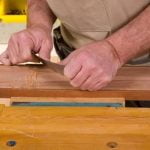Rusty woodworking tools can be a significant challenge for woodworking enthusiasts. The frustrating dilemma of rusty tools is all too familiar to those who have experienced it. Not only does rust hinder the performance of these essential instruments, but it also poses a threat to their longevity. In this article, we will delve into effective solutions to clean up rusty woodworking tools and bring them back to their full potential.
Woodworking tools are susceptible to rust due to their exposure to moisture and humidity in workshop environments. Rust not only affects the visual appeal of the tools but also compromises their precision and functionality. It can lead to corrosion, pitting, and even damage if left unattended.
To avoid these detrimental effects, regular maintenance is crucial. By understanding the root causes and consequences of rust, woodworkers can take proactive measures to prevent its accumulation on their tools. In this article, we will explore various techniques and alternative methods for cleaning up rusty woodworking tools effectively.
Whether you are a seasoned woodworker or just starting out in the craft, this comprehensive guide will provide you with step-by-step instructions, vital tools and supplies needed for cleaning rust, as well as alternative natural methods for rust removal. Additionally, we will address common troubleshooting scenarios and offer guidance on long-term restoration and maintenance practices.
Don’t let rusty woodworking tools hold you back from pursuing your passion. With proper cleaning techniques and preventative measures, you can restore your beloved tools to their former glory and enjoy enhanced woodworking experiences for years to come. Let’s dive into the world of rusty tool cleanup together.
Understanding Rust and Its Effects on Woodworking Tools
Rust is a common problem that woodworking enthusiasts often encounter with their tools. Understanding the composition, causes, and effects of rust is crucial in order to effectively clean and prevent it from damaging woodworking tools.
Rust is a corrosion process that occurs when iron or steel interacts with oxygen and moisture. The presence of these elements triggers the formation of iron oxide, which weakens the structure of the metal. This can have detrimental effects on woodworking tools, compromising their precision and longevity.
When rust forms on woodworking tools, it can cause several issues. First, rust can interfere with the smooth movement of tool components, affecting their functionality and accuracy. For hand planes or chisels, this can result in uneven cuts or unwanted marks on wood surfaces. Additionally, rust weakens the structural integrity of tools, making them more prone to breakage or failure over time.
Regular maintenance is essential for preventing rust accumulation. This includes cleaning tools after use and storing them in a dry environment. Applying a protective coating such as wax or oil can also help create a barrier against moisture and prevent rust from forming.
It’s important for woodworking enthusiasts to understand the impact of rust on their tools so they can take proactive measures to prevent its occurrence. By regularly inspecting their tools for signs of rust and implementing proper cleaning and maintenance routines, they can ensure that their woodworking tools remain in excellent condition for years to come.
| Rusty Tool Symptoms | Impacts on Woodworking Tools |
|---|---|
| Discoloration and reddish-brown patches | Interferes with tool movement, affect functionality |
| Loose or stuck components | Compromises accuracy and precision |
| Pitting or corrosion | Weakens structural integrity, increases risk of breakage |
| Rough or jagged cutting edges | Results in uneven cuts and marks on wood surfaces |
Assessing the Damage
Step-by-Step Guide to Assessing Rust on Woodworking Tools
When it comes to cleaning rusty woodworking tools, it is essential to first assess the extent of rust and damage on the tools. This step will help determine the appropriate cleaning methods and supplies needed for effective restoration. Here is a step-by-step guide on how to assess the damage caused by rust on your woodworking tools:
- Inspect the Tools: Carefully examine each tool for signs of rust. Look for discoloration, roughness, or pitting on the tool’s surface. Pay close attention to areas where there may be hidden rust, such as screw heads or joints.
- Determine the Level of Damage: Once you have identified rust on your tools, classify it into one of three levels: light surface rust, moderate pitting, or severe corrosion. Light surface rust typically appears as a thin layer that can easily be cleaned off.
Moderate pitting is characterized by deeper corrosion spots on the tool’s surface but does not compromise its functionality. Severe corrosion involves extensive damage that may affect the structural integrity and performance of the tool. - Use Visual Examples: To better understand and identify each level of rust damage, refer to visual examples and illustrations available online or in woodworking resources. These visuals will help you compare your own tools to determine the appropriate course of action.
Taking Action Based on Rust Assessment
Once you have assessed the extent of rust on your woodworking tools, you can proceed with selecting suitable cleaning methods and supplies. Here are some general recommendations based on different levels of damage:
- Light Surface Rust: If your tools have only light surface rust, they can usually be cleaned using simple methods such as scrubbing with a wire brush, sanding with fine-grit sandpaper, or using a rust remover solution. Light surface rust can often be removed without causing significant damage to the tool.
- Moderate Pitting: For tools with moderate pitting, more intensive cleaning methods may be required. Consider using abrasive pads or rust removal products specifically designed for tougher rust stains. These solutions help remove deeper corrosion while minimizing damage to the tool’s surface.
- Severe Corrosion: In cases of severe corrosion, restoring the tool’s functionality may be challenging. Assess whether it is worth investing time and effort into extensive restoration or if it would be more practical to replace the tool altogether.
Remember, proper assessment of rust on your woodworking tools is crucial for determining the appropriate cleaning methods and ensuring successful restoration. By understanding the level of damage caused by rust, you can effectively choose the right techniques and supplies needed to bring your tools back to their former glory.
Essential Tools and Supplies for Cleaning Rusty Woodworking Tools
Cleaning rusty woodworking tools requires a specific set of tools and supplies to effectively remove rust and restore the functionality of the tools. Here is a comprehensive list of essential items you will need for the cleaning process:
- Wire brush: A wire brush is essential for removing loose rust, dirt, and grime from the surface of the tools. Choose a brush with stiff bristles to effectively scrub away rust particles.
- Sandpaper or abrasive pads: Depending on the extent of rust on your woodworking tools, you may need different grits of sandpaper or abrasive pads. Coarser grits like 80 or 120 are suitable for heavy rust, while finer grits like 220 or 320 can be used for light surface rust.
- Rust remover solution: There are several commercial rust remover solutions available in the market that can help dissolve rust and facilitate its removal from your tools. Look for products that are specifically designed for metal surfaces.
- Protective coatings: After removing rust from your woodworking tools, it’s important to protect them from further corrosion. Applying a protective coating such as paste wax, oil, or lacquer can help prevent future rust formation.
- Disposable gloves: To protect your hands from any chemicals used during the cleaning process, it’s recommended to wear disposable gloves. This will also help prevent any oils or moisture transferred from your hands onto the cleaned tools.
- Safety goggles and mask: Rust removal typically involves scraping or brushing away small particles that can become airborne. Protect your eyes with safety goggles and wear a mask to avoid breathing in any dust or chemical fumes.
In addition to these essential items, there are also some readily available alternatives you can consider using:
- Vinegar: Vinegar has mild acidic properties that can help dissolve light surface rust on woodworking tools. Soaking the affected areas in vinegar overnight can loosen the rust for easier removal.
- Lemon juice: Similar to vinegar, lemon juice can be used as a natural rust remover. Squeeze fresh lemon juice onto the rusty areas and let it sit for a few hours before scrubbing with a wire brush.
- Baking soda: Creating a paste by mixing water and baking soda can also help remove rust from woodworking tools. Apply the paste to the rusted areas and scrub gently with a cloth or soft brush.
By having these essential tools and supplies on hand, you’ll be well-equipped to tackle the task of cleaning up your rusty woodworking tools effectively. Remember to always follow proper techniques and safety guidelines to ensure successful restoration of your tools.
Step-by-Step Guide
Now that we understand the effects of rust on woodworking tools and how to assess the damage, it’s time to dive into the step-by-step guide on cleaning up rusty woodworking tools. By following these instructions, you can effectively remove rust and restore your tools’ functionality.
- Gather all necessary tools and supplies: Before starting the cleaning process, make sure you have everything you need. Some essential items include a wire brush, sandpaper (various grits), a rust remover solution, protective coatings (such as oil or wax), lint-free cloths, and disposable gloves. These tools and supplies will help facilitate the rust removal process.
- Remove loose rust with a wire brush: Begin by using a wire brush to remove loose flakes of rust from the tool’s surface. Gently scrub in circular motions until most of the loose rust is eliminated. Be careful not to apply excessive force that could damage the tool’s surface.
- Sanding away surface rust: After removing loose rust, progress to sanding the tool’s surface with sandpaper. Start with a coarse-grit paper (around 80 grit) and gradually work your way to finer-grit papers (such as 120 or 240 grit). This process will help eliminate any remaining traces of surface rust while providing a smooth finish.
- Utilize a rust remover solution: For more severe cases of rust or stubborn spots, you may consider using a commercial rust remover solution following the manufacturer’s instructions carefully. Apply the solution onto a cloth or sponge and gently rub it onto the affected area. Allow it to sit for the recommended time before rinsing it off thoroughly with clean water.
- Dry and protect: After removing all traces of rust, make sure to dry your woodworking tools completely using lint-free cloths to prevent any residual moisture that could lead to further corrosion. Once dry, apply a protective coating such as oil or wax to prevent future rusting.
It’s worth noting that different tools may require specialized cleaning techniques. For hand planes, for example, disassembling the components and soaking them in a rust remover solution overnight before thorough cleaning could be necessary. Similarly, saw blades might require careful cleaning with a mild detergent and toothbrush.
By following this step-by-step guide, you can confidently clean up your rusty woodworking tools and restore their functionality. Remember to take your time, be patient, and always prioritize safety throughout the process. With regular maintenance and proper storage practices, you can keep your tools rust-free and enjoy enhanced woodworking experiences for years to come.
Alternative Techniques
In addition to traditional rust removal methods, there are also natural alternatives that can effectively remove rust from woodworking tools. These methods are not only environmentally friendly but also easily accessible and cost-effective. By utilizing everyday household items such as vinegar, lemon juice, or baking soda, woodworkers can achieve satisfactory results in restoring their rusty tools.
One of the most commonly used natural rust removal methods is vinegar. Its high acidity makes it an excellent rust dissolver. To use vinegar for rust removal, soak the affected tool in a container filled with vinegar for several hours or overnight. Afterward, scrub off the loosened rust using a wire brush or abrasive pad. Rinse the tool thoroughly with water and dry it completely to prevent further corrosion.
Lemon juice is another natural substance that can effectively remove rust from woodworking tools. Similar to vinegar, lemon juice’s acidity helps dissolve rust and restore the tool’s surface. To use lemon juice for rust removal, squeeze fresh lemon juice onto the affected area and let it sit for about 10-15 minutes before scrubbing it with a wire brush or abrasive pad. Rinse the tool with water and dry it thoroughly.
Baking soda is a less acidic alternative that can be combined with other substances to enhance its rust-removing properties. Create a paste by mixing baking soda with water or lemon juice to form a thick consistency. Apply the paste onto the rusty areas of the woodworking tool and let it sit for approximately 30 minutes. Use a cloth or sponge to scrub away any loose rust particles, then rinse with water and dry thoroughly.
Combining different natural methods can often lead to better results in removing tough rust stains from woodworking tools. For instance, you may choose to soak your tool in vinegar first and then apply a baking soda paste afterward for further cleaning power.
By utilizing these natural rust removal methods, woodworkers can effectively restore their rusty tools without relying on harsh chemicals. However, it is important to note that prevention is key to avoiding rust in the first place. Regular cleaning, proper storage, and applying protective coatings will help maintain tools’ longevity and prevent rust from forming.
Restoration and Maintenance
Woodworking tools are essential for any woodworking enthusiast, but their longevity and performance can be significantly hampered by rust. Rust not only affects the precision of the tools but also reduces their lifespan. Therefore, it is crucial to focus on restoration and maintenance to ensure the longevity of your woodworking tools.
Guidance on prolonging tool lifespan through preventative measures
Prevention is always better than cure when it comes to rust on woodworking tools. The first step in preserving your tools is to store them properly. Moisture and humidity are major contributors to rust formation, so it is important to keep your tools in a dry environment. Consider using a dehumidifier or silica gel packs in your tool storage area to absorb excess moisture.
Furthermore, applying a protective coating or lubrication to your tools can help prevent rust formation. When you finish using a tool, wipe it clean with a dry cloth and apply a thin layer of protective oil or wax. This creates a barrier between the metal surface and moisture, reducing the chances of rusting.
Recommendations for storage methods and protective coatings
When storing your woodworking tools, consider hanging them on a pegboard or using a toolbox with individual compartments. This will help prevent any contact between metal surfaces that could lead to scratches and potential areas for rust formation.
Using silica gel packs in your toolbox or storage containers can also help absorb any residual moisture that may be present after cleaning the tools. Change the silica gel packs regularly or when they indicate saturation levels based on their color-changing properties.
Additionally, consider investing in anti-rust paper or VCI (vapor corrosion inhibitor)-treated papers for long-term storage of larger or less frequently used woodworking tools. These papers release vapor molecules that inhibit rust formation on metal surfaces, providing an extra measure of protection against corrosion.
Highlighting the significance of regular cleaning and maintenance routines
Regular cleaning and maintenance routines are essential for preserving your woodworking tools. After each use, take the time to clean off any debris or sawdust from the tool’s surface. Use a dry cloth or soft brush to remove loose particles that may contribute to rust formation.
In addition to regular cleaning, it is important to inspect your tools for any signs of rust regularly. This allows you to catch early stages of rust formation and take immediate action before it worsens. By integrating these cleaning and maintenance routines into your woodworking practice, you can ensure that your tools remain in excellent condition for years to come.
By following these restoration and maintenance practices, woodworking enthusiasts can preserve the quality and lifespan of their tools. With proper care and preventative measures against rust, you can enjoy using your woodworking tools for the long haul without worrying about diminished performance or unnecessary replacement costs.
Troubleshooting and Common Pitfalls in Rusty Woodworking Tools Cleanup
Addressing Potential Complications during the Cleaning Process
Cleaning up rusty woodworking tools can be a challenging task, and there may be some complications that arise during the process. One common issue that woodworkers may encounter is stubborn rust. Despite following the cleaning steps diligently, some tools may still have areas of persistent rust. In such cases, it is important not to panic but to try alternative techniques until the desired outcome is achieved.
If certain areas of rust prove resistant to removal, one effective method is using a paste made from baking soda and water. This mixture can be applied directly to the rusted areas, left for a few minutes, and then scrubbed off with a wire brush or sandpaper. Additionally, a small amount of white vinegar or lemon juice can be added to the paste for enhanced effectiveness.
Another common pitfall in rusty woodworking tools cleanup is accidentally damaging the tool’s surface or removing its protective coating while trying to remove rust. To avoid this issue, it is crucial to use gentle cleaning techniques and avoid applying excessive pressure. Carefully follow the instructions provided in previous sections for each specific type of tool.
Troubleshooting Guide for Stubborn Rust Cases or Damaged Tools
In some cases, despite trying various cleaning methods, there may still be instances where rust persists on certain woodworking tools or where damage has already occurred due to prolonged rust exposure. In such situations, it may be necessary to seek professional help from a tool restoration specialist or local woodworking store.
Professionals have access to specialized equipment and expertise that can effectively remove even the most stubborn rust or salvage heavily corroded tools. It’s important not to give up hope and consult an expert who can assess the extent of damage and provide suitable solutions such as sandblasting, regrinding, or recoating.
For those who prefer cost-effective alternatives before considering professional assistance, it may be worth exploring online forums and communities of woodworking enthusiasts. These platforms can provide valuable advice and tips from experienced individuals who have encountered similar challenges with rusty tools. Engaging with these communities and seeking guidance may lead to innovative solutions that can revive tools and extend their lifespan.
By being proactive in seeking solutions for stubborn rust cases or damaged tools, woodworkers can ensure that their cherished tools are restored to their full functionality, allowing them to continue pursuing their woodworking passions.
Encouragement to Seek Professional Help If Necessary and Insights on Cost-Effective Alternatives
While many rust removal techniques can be successfully performed by woodworking enthusiasts themselves, there may be instances where the damage is extensive or the restoration process requires specialized equipment. In such cases, it is essential not to hesitate in seeking professional help from experts in tool restoration.
Professional restoration services can breathe new life into heavily rusted or damaged tools by utilizing advanced techniques like electrolysis, which removes rust through an electrical charge. Additionally, skilled professionals can assess the overall condition of the tool and provide recommendations for preventative measures to avoid future rusting.
For those seeking more cost-effective alternatives, visiting local pawn shops or flea markets can be worth exploring. These places often have a wide variety of used tools at affordable prices that may require some cleaning but are still functional. This route allows woodworkers to acquire additional tools without breaking the bank while honing their skills in restoring rustic tools themselves.
Remember, regardless of the approach chosen – whether it is seeking professional assistance or exploring cost-effective alternatives – the ultimate goal is to ensure that rusty woodworking tools are restored or replaced so that woodworking projects can be pursued with optimal precision and performance.
Conclusion
In conclusion, dealing with rusty woodworking tools can be a frustrating and time-consuming task. However, by understanding the nature of rust and its effects on equipment, identifying the extent of damage, and following a step-by-step cleaning process, you can effectively restore your tools to their former glory. Additionally, exploring alternative techniques like natural rust removal methods can provide environmentally friendly options for those who prefer to avoid harsh chemicals.
To ensure the longevity and performance of your woodworking tools, it is crucial to implement regular maintenance routines and preventative measures. Storing your tools in a dry environment and applying protective coatings will help prevent rust accumulation. Furthermore, taking the time to clean your tools after each use will go a long way in preserving their condition over time.
It is important to note that while DIY methods can often successfully clean up rusty woodworking tools, there may be instances where professional help is needed. If you encounter stubborn rust cases or have severely damaged tools that require expert restoration, do not hesitate to seek professional assistance.
By taking care of your woodworking tools and keeping them rust-free, you can enhance your overall woodworking experiences. With confidence and motivation, embrace the opportunity to bring your collection back to life. Remember that a well-maintained set of tools not only ensures precision but also contributes to the enjoyment of creating beautiful woodwork projects for years to come.
Frequently Asked Questions
How do you remove rust from woodworking tools?
Rust is a common problem for woodworking tools, but it can be effectively removed with the right techniques. One method is to scrub the rusted areas with steel wool or a wire brush to remove as much surface rust as possible. Afterward, you can apply a solution of vinegar and water or a commercial rust remover to further loosen and dissolve the remaining rust.
For tougher cases, sandpaper can be used to sand down the rusted areas until the metal underneath is exposed. Finally, applying a protective coat such as oil or wax can help prevent future rusting and keep your woodworking tools in good condition.
Should I throw away rusted tools?
While it may be tempting to throw away rusty tools, it’s not always necessary. Tools that are heavily corroded or damaged beyond repair may indeed need to be discarded. However, many rusty tools can be restored back to their functional state with some effort and care.
If the tool holds sentimental value or is of high quality, it may be worth attempting to save it rather than immediately discarding it. By removing the rust and properly maintaining the tool moving forward, you can often extend its lifespan and continue using it effectively.
Can rusty hand tools be saved?
Rusted hand tools can often be saved if you take appropriate steps in their restoration process. Begin by assessing the extent of corrosion on each tool – superficial amounts of rust can typically be addressed through cleaning and basic restoration techniques mentioned earlier. However, if the rust has significantly compromised structural integrity or affected crucial parts of the tool, it might not be practical to salvage it.
Additionally, consider whether alternative replacements are readily available for specific tools that cannot easily be restored or would cost more to fix than replace. It’s important to weigh both sentimental value and practicality when deciding whether rusty hand tools should be saved or replaced.

Hi everyone! I’m a woodworker and blogger, and this is my woodworking blog. In my blog, I share tips and tricks for woodworkers of all skill levels, as well as project ideas that you can try yourself.





